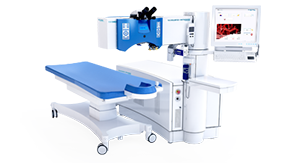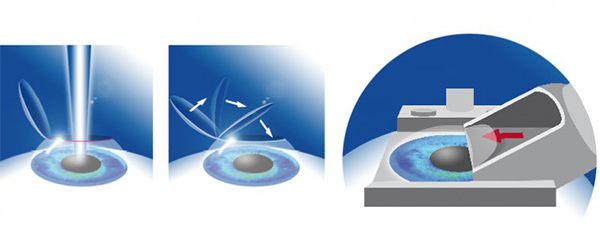Refractive Surgery | Innova ocular
What is Refractive Surgery?
Refractive surgery refers to the techniques used to eliminate or minimise refractive eye problems such as myopia, hyperopia and astigmatism.
The use of Excimer laser is currently the treatment of choice in refractive surgery to correct this type of eye problems.

However, when the patient is not a candidate for refractive surgery with Excimer laser, there are other surgical alternatives, such as an intraocular lens implant.
The prestige of Innova Ocular clinics is based on use of the latest techniques and a thorough preliminary study that is personalised for each case, which we perform for all patients in order to offer the greater possible guarantee of success.
LASIK
This is the most widely used technique worldwide for correcting refractive defects. It is a simple, fast, safe, painless, personalised operation, which is carried out in three steps:

-
It consists of creating a thin flap on the surface of the cornea using a specially designed tool called a microkeratome. Once the flap has been created, it is folded back so that Excimer laser can be used.
-
The surgeon applies Excimer laser to reshape the intermediate layer of the cornea, which takes between 5 and 45 seconds, depending on the type and magnitude of the defect being treated. The laser equipment has a safety mechanism that controls eye movements, known as an eye tracker, which makes it possible to direct the beam only at the parts of the cornea that need to be reshaped to correct the refractive defect.
-
Once the laser has performed its task, the thin flap of cornea is laid back in place.
This entire process takes 10 to 15 minutes and is completely painless. During the first few hours the patient may notice some slight discomfort, such as stinging or watering, and after a few hours, they will start to experience an improvement in their vision, without the need to depend on glasses or contact lenses.
LASIK with Femtosecond Laser
This technique has revolutionised laser refractive surgery, as instead of cutting the lenticule to create a flap on the surface of the cornea, a technique is used that does this by femtosecond laser.

-
A thin flap is created on the surface of the cornea using the femtosecond laser. Once the flap has been created, it is folded back so that Excimer laser can be used.
-
The surgeon applies Excimer laser to reshape the intermediate layer of the cornea, which takes between 5 and 45 seconds, depending on the type and magnitude of the defect being treated. The laser equipment has a safety mechanism that controls eye movements, known as an eye tracker, which makes it possible to direct the beam only at the parts of the cornea that need to be reshaped to correct the refractive defect.
-
Once the laser has performed its task, the thin flap of cornea is laid back in place.
This entire process takes 10 to 15 minutes and is completely painless. During the first few hours the patient may notice some slight discomfort, such as stinging or watering, and after a few hours, they will start to experience an improvement in their vision, without the need to depend on glasses or contact lenses.
PRK
This technique is performed on the surface of the cornea. It involves separating the corneal epithelium, the most superficial layer of the cornea. A special alcohol solution is used to clean the outermost part of the eye in order to work with the laser on a stable area; an Excimer laser can then be applied to the clean corneal bed.

The operation takes approximately 10 to 15 minutes and, as with Lasik, is performed under topical anaesthesia (eye drops). Once the effects of the anaesthetic have worn off, the patient may experience some discomfort for the first few days.
When a surface technique is used, recovery will be gradual; it is possible to return to normal life one week after the operation.
ICL
This is a technique used to correct myopia that involves implanting an extremely fine and malleable lens inside the eye. It is additive surgery, which means that no tissue is removed from the eye and it is therefore a reversible procedure. It is generally used in young patients with a high refractive defect, although there are also other indications.
The surgeon injects the lens (which is specific and unique to each eye) behind the iris and in front of the crystalline lens into a space called the posterior chamber, where it will act in a similar way as a contact lens, with the advantage that it is invisible and does not cause discomfort.

This lens does not require any kind of maintenance after it is implanted and it is completely biocompatible. There are different types of lens; our doctors will advise you as to the most recommendable type in your case.
The operation takes between 15 and 20 minutes and no stitches are required. We do not operate on both eyes on the same day. The patient is able to go home without wearing a dressing over the eye and visual recovery is very quick.